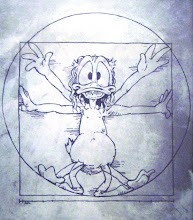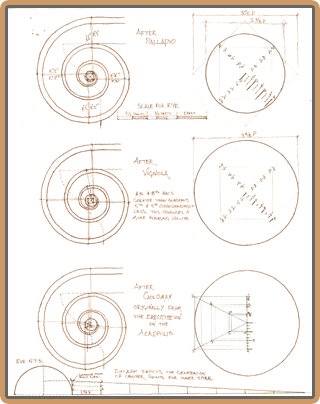Today, I'm going to contradict myself. Or at least it will seem that way for those who ignorantly believe that Liberal Education means an immersion in all things donkey.
After having discussed the need for knowing the rules of the Trivium, what we now need to understand is that while the rules of Grammar, Logic and Rhetoric ought to be learned by all, those same rules can be bent to great pleasure and effect by competent Liberal Artists. To follow the letter of the law (of letters), gives rise to stagnant prose and dead poetry. But to bend the rules for effect is greatly admirable. One must be mindful that bending the rules does not mean breaking the rules. To break a rule is to deny it's existence. This is anarchy. For example, when Gertrude Stein or ee cummings denies the worth of punctuation or conventional grammar, it is breaking the rules for the sake of breaking the rules, which leads to a breakdown in communication. But for a writer such as J.R.R. Tolkien, when one bends the rules, one does so to elevate the level of communication and heighten awareness. Tolkien takes liberties with the rules to free himself from the bonds of mediocrity. Stein takes artistic license with the rules and ends up confusing the reader. The problem with artistic license is that it usually leads to things more licentious than artistic. But I digress.
In The Lord of the Rings, Tolkien repeats this poem:
- All that is gold does not glitter,
- Not all those who wander are lost;
- The old that is strong does not wither,
- Deep roots are not reached by the frost.
- From the ashes a fire shall be woken,
- A light from the shadows shall spring;
- Renewed shall be blade that was broken,
- The crownless again shall be king.
Actually, in this case, he is showing us just how well educated he is. That first line employs a figure of speech called HYPERBATON, which alters the proverbial "All that glitters is not gold" from Shakespeare's MERCHANT OF VENICE, which in turn is an alteration of the order of the earlier Roman proverb "Non omne quod nitet aurum est" (Not all which shines is gold)
Here, both authors are using the altered order for rhythm and punctuated meaning. Moreover, we know Tolkien clearly understands the difference in meaning, as he immediately follows the first line with the more grammatically correct "Not all who wander are lost". This is to say he understands the Aristotelian distinction between "All X are not Y" and "Not all X are Y". He is emphasizing the difference between negative predication to a positive universal and positive predication to individuals; and in so doing is calling to our attention his ulterior intentions.
For Tolkien, another sense of gold is meant here, and then it becomes semantically true that nothing gold glitters: There are at least three levels of meaning which are intended. The literal level is patently false. Gold does, in fact, glitter, and is beautiful. This reminds me of St. Thomas Aquinas' definition of beauty:
"beauty includes three conditions, integrity or perfection [integritas], since those things which are impaired are by the very fact ugly; due proportion or harmony [proportio]; and lastly, brightness or clarity [claritas], whence things are called beautiful which have a bright color.”-Summa Theologica, Prima. Q.39, Art. 8.
But in the story, the Ring is made of gold. And doesn't it glitter par excellence? Not really. Recall that it's not through the material qualities of the gold that the ring glitters, it is because of its power, its form. In fact, the ring is actually described as rather boring in design, not even holding a gem like the lesser rings. It doesn't grab attention by it's looks. It is through clarity of form that the gold ring glitters. Besides, the glistening ring represents the gaudy attraction of sin, which is far from valuable, far from true gold.
Truly, the poem as a whole is about Aragorn. Aragorn is the crownless king of men. He, as Strider, scares the hobbits. He is homeless, wandering, ugly and dirty. He has no lustrous draw. But on a symbolic level, we know he is true gold, and he stands the trial of fire. In this, he is a Christ figure.
In yet a deeper level of metaphor, Christ is the gold which doesn't glitter. Christ is by His Divine Nature vastly more resplendent than fallen man: in fact, infinitely so. Yet the paradox of Jesus Christ is that he came to this world in the form of the most humble of circumstances, and took upon himself not the life of a King with golden crown, but as a poor servant. From Isaiah, Chapter 53:
- 2...There was in him no stately bearing to make us look at him, nor appearance that would attract us to him.
- 3 He was spurned and avoided by men, a man of suffering, accustomed to infirmity, One of those from whom men hide their faces, spurned, and we held him in no esteem.
Had Tolkien followed the letter of the law of word order, these more subtle symbols would have died in his own mind. There would have been no rhetorical communication. The letter killeth, but the Spirit giveth life. A true artist, a liberal artist, knows where and how far he can bend the rules by first knowing what the rules are.
So with this in mind, let's all pick up the PRIOR and POSTERIOR ANALYTICS, as well as the TOPICS, and get Aristartled!!!



4 comments:
Yet another case of reading way too much into Tolkien. He most likely did not even think of half of those things. You can do this same thing with your daily newspaper story, and no mistake.
Thanks for your insightful reasoning, your ample citations and examples, not to mention the exemplary use of subordinate clauses.
However, the thought that someone like me, spending an hour writing a little blog entry, is thinking of waaaaay more than Tolkien did writing an epic over a lifetime is patently absurd.
This is especially true of Tolkien-he developed his own frickin' language for the books, for crying out loud.
Is your problem that he was in fact Catholic, and just might have put some of his beliefs into his work? Gasp!!!
I find myself wondering if it's the depth of the interpretation Mr. Anonymous objects to, or the content. I'm inclined to think it's the "Aragorn as Christ figure" myself...but I'm not always as discerning or as charitable as I could/should be. Perhaps if we had a little more to go on…
Oh, and I've got to find myself some of those daily newspapers he's talking about. There is apparently a much higher quality of news writing out there than I've experienced in my (admittedly limited) newspaper experience.
Mr. Anonymous, being a Catholic, objects to neither. Provisionally I enjoy the LOTR too. Alas, the phenomenon of reading too much into Ron is quite noted; one does not need to provide documentation or links for that. Now, I suppose if I object to anything it is how Ron basically ripped Wagner's Ring Trilogy and The Wizard of Oz off. Do you need documentation and links for that too? I won't even go into the profound racism that they both share. Of course, one must possess the perspicacity to detect all of these things....
Post a Comment